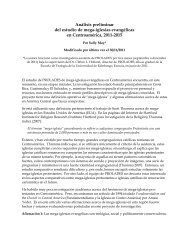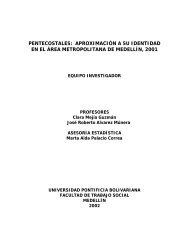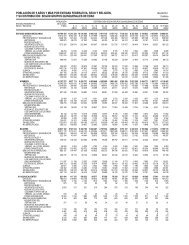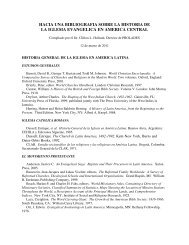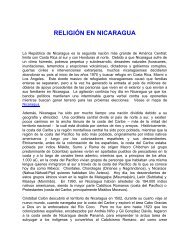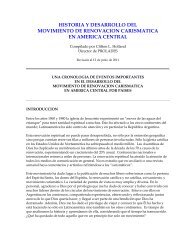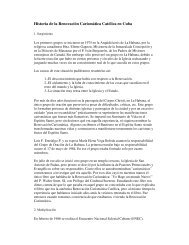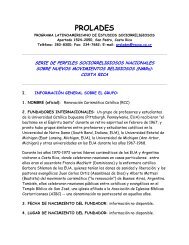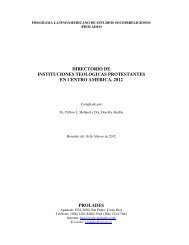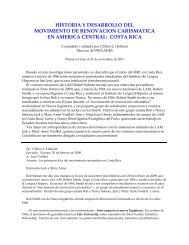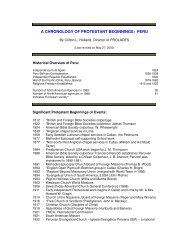belize, 1980 - Prolades.com
belize, 1980 - Prolades.com
belize, 1980 - Prolades.com
Create successful ePaper yourself
Turn your PDF publications into a flip-book with our unique Google optimized e-Paper software.
4.2 ROMAN CATHOLIC CHURCH<br />
Although the Roman Catholic Church was not officially present in British Honduras until 1851<br />
when the first Catholic missionary arrived, by 1860 the Catholic Community in Belize City accounted<br />
for 15% of the total population. The arrival of the first resident Jesuit from Jamaica, Fr. Eustace du<br />
Peyron, in 1851 marked the permanent establishment of the Roman Catholic Church in Belize. The<br />
Holy Redeemer Cathedral was built – with massive columns of solid mahogany – in Belize City in<br />
1858.<br />
However, the growth of the Catholic Church in Belize prior to 1900 occurred chiefly among<br />
the Amerindian and Mestizo peoples in rural areas, and not among the Creoles in Belize City. Even<br />
as the early Protestant Churches in Belize grew mainly from the influx of West Indian migrants, so<br />
also the Roman Catholic Church there increased principally due to the arrival of Indian refugees<br />
from Yucatan who settled in the northern lowlands of Belize during the late 1840s, as well as from<br />
the migration of other Amerindian and Mestizo peoples from Guatemala after 1850.<br />
The missionary zeal of the English Jesuits between 1869 and 1894, and of the American<br />
Jesuits from the Missouri Province (USA) since 1894, have strengthened the position of the Catholic<br />
Church in Belize, mainly among the Amerindian and Mestizo peoples. The Vicariate Apostolic of<br />
British Honduras was created in 1893 under Bishop Salvatore di Pietro, SJ, but it was not until<br />
1956 that the Diocese of Belize (under Bishop David Francis Hickey, SJ) was established under<br />
the Archdiocese of Kingston, Jamaica. The Jesuits, aided by other religious orders, established<br />
schools and social ministries, in addition to parish churches, throughout the country among the<br />
larger ethnic groups.<br />
Today, Roman Catholics predominate in every administrative district, with the exception of<br />
the District of Belize, where 55% of the population is Protestant and largely Creole. As the Mestizo<br />
and Amerindian segments of the population increase during <strong>com</strong>ing years, along with a corresponding<br />
decrease in the proportion that is Creole, the size of the Catholic Community will tend to<br />
increase as well. (Note: In 1984, Bishop Robert Louis Hodapp, SJ, retired after 26 years as the last<br />
Jesuit bishop of Belize. The first Belizean-born prelate, Most Rev. Osmond Peter Martin, was<br />
appointed Bishop of the Diocese of Belize City and Belmopan at that time.)<br />
There is little evidence that the Catholic Charismatic Renewal Movement on the one<br />
hand, or that Liberation Theology on the other hand, has had much impact on the Roman<br />
Catholics of Belize.<br />
V. FOREIGN MISSIONS<br />
5.1 THE PROTESTANT MOVEMENT<br />
Since it’s founding about 1638 (definitely by 1662), the thinly populated Belize Settlement<br />
was noted for its wickedness and immorality. Contemporary historians cited various "evil influences"<br />
in the Colony: the demoralizing effects of slavery; the presence of an idle military force, which<br />
consisted of two or three <strong>com</strong>panies of the West India Regiment that protected the Colony from<br />
Spanish intrusions; the lack of churches and schools; the ungodly example set by unconverted<br />
Europeans (mainly English, Scotch, German and French) who were drawn to the Colony by greed;<br />
and the ac<strong>com</strong>panying licentious behavior among the conglomerate population concentrated in<br />
Belize City that derived its livelihood from the logwood and mahogany trade.<br />
33



